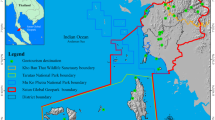Abstract
This research has identified areas located in the northern coastline of the Persian Gulf in the south of Iran, as strategic and ecological sites, based on tourism potential assessing criteria. To this end coastal limits were identified by satellite imagery in terms of shorelines and the maximum extent of water approach into the land and taking into consideration the characteristics of the nearby coastal villages. The studied region was then compared to similar international criteria and experiences. The original criteria were then divided into three main and four sub criteria. The Kangan region was found to have a potential for tourism industry according to the mentioned criteria. Naiband Gulf with a score of 20 was ranked first followed by Asalouyeh with a score of 18 and finally Taheri and Kangan Ports with scores of 16 and 15, respectively. With a high tourism industry potential in the studied region the necessity of ecotourism quality enhancement and environmental management planning for the northern shoreline of the Persian Gulf becomes of vital importance.


Similar content being viewed by others
References
Burger J (2002) Tourism and ecosystem. In: Douglas, 1st edn. Causes and consequences of global climate change. Encyclopedia of global environmental change, vol 3. Wiley, Chichester, pp 597–609
Camhis M, Coccossis H (1982) Coastal planning and management perspectives. Ekistics 49 293:92–97
Capobianco M (1999) EU demonstration programme on integrated management in coastal zones 1997–1999: role and use of technologies in relation to ICZM. Final report, Tecnomare S.P.A., Venezia
Cater E (1993) Ecotourism in the third world: problems for sustainable tourism development. Tour Manage 14:85–89
Clark JR (1983) Coastal ecosystem management (a technical manual for the conservation of coastal zone resources). Wiley, New York, pp. 928
Coccossis H (1996) Tourism and sustainability: perspectives and implications in sustainable tourism? In: Priestley G, Edwards A, Coccossis H (eds) London CAB International, pp 1–21
Davenport J, Davenport J (2006) The impact of tourism and personal leisure transport on coastal environments: a review. Estuar Coast Shelf Sci 67:280–292
Driml S, Common M (1996) Ecological criteria for sustainable tourism: application to the Great Barrier Reef and wet tropics world heritage areas, Australia. J Sustain Tour 4:3–16
EC (1998) European Commission, DGXXIII.1998. Fact and figures on the European on holiday 1997–1998. Euro barometer, 48, Brussels
FAO (1996) World information early warning system on plant genetic resource. http://www.fao.org/world/afghanistan/pubs_pgr_en.htm
Font X, Tribe V (1999) Forest tourism and recreation. CABI Publication LONDON. Buckinghamshire chi tern’s University, Wycombe
Jarvilouma J (1992) Alternative tourism and the evolution of tourist area. Tour Manage 13:118–120
Kelly MG (1980) Remote sensing of seagrass beds. In: Phillips RC, Mc Roy CP (eds) Handbook of seagrass biology: an ecosystem perspective, Garland, New York, pp 69–86
Madan S, Rawat L (2000) The impacts of tourism on the environment of Mussoorie, Garhwal Himalaya, India. Environmentalist 20(3):253–259
Mciwem D (2006) Likely sensitivity of bottlenose dolphins to pile-driving noise. Water Environ J 20:48–54
Nash D, Butler R (1990) Alternative forms of tourism. Int J Hosp Manage 9:163–165
Nouri J, Malmasi S (2004) Environmental impact assessment of urban development plan by vulnerability model application. Int J Environ Sci Technol 1(1):7–15
Pak A, Farajzadeh M (2007) Iran’s integrated coastal management plan: Persian Gulf, Oman Sea, and southern Caspian Sea coastlines. Ocean Coast Manage(in press)
Pasqualini V, Pergent-Martini C, Fernandez C, Pergent G (1997) The use of airborne remote sensing for benthic cartography: advantages and reliability. Int J Remote Sens 185:1167–1177
Sorensen J, McCreary S (1990) Institutional arrangements for managing coastal resources and environments, US Nat. Parks Service, Int. Affairs Office, DC (1990)
Stewart S, Sckartjakrarini S (1994) Disentangling ecotourism. Ann Tour Res 21:840–842
US NEPA (1969) National Environmental Policy Act, Government Press, Washington, DC (1996)
Weaver DB (1991) Alternative to mass tourism in Dominica. Ann Tour Res 18:414–432
Weaver DB (1993) Ecotourism in the small Island Caribbean. Geo J 3:457–465
Weaver DB (1999) Magnitude of ecotourism in Costa Rica and Kenya. Ann Tour Res 26:792–816
Weaver DB (2005) Comprehensive and minimalist dimension of ecotourism. Ann Tour Res 32:432–455
World Tourism Organization (WTO) (2004) http://www.world-tourism.org/facts
Author information
Authors and Affiliations
Corresponding author
Rights and permissions
About this article
Cite this article
Nouri, J., Danehkar, A. & Sharifipour, R. Evaluation of ecotourism potential in the northern coastline of the Persian Gulf. Environ Geol 55, 681–686 (2008). https://doi.org/10.1007/s00254-007-1018-x
Received:
Accepted:
Published:
Issue Date:
DOI: https://doi.org/10.1007/s00254-007-1018-x




